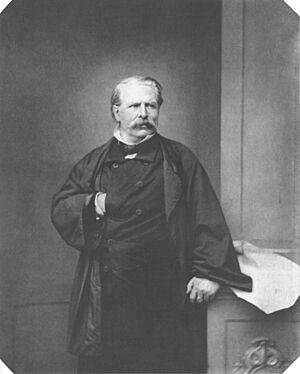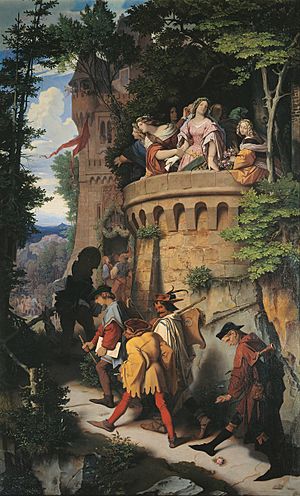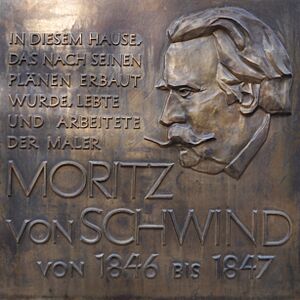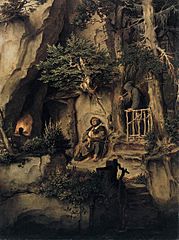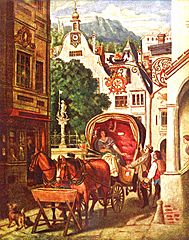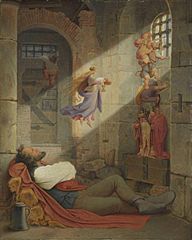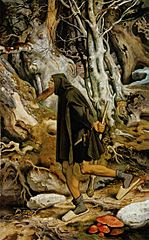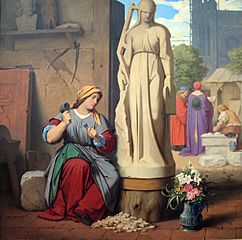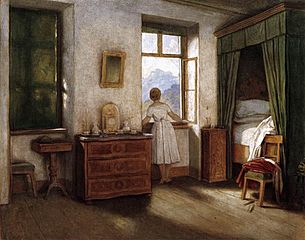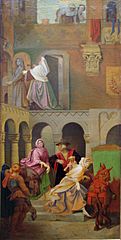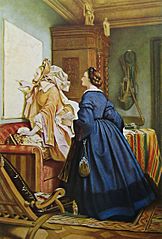Moritz von Schwind facts for kids
Moritz von Schwind (born January 21, 1804 – died February 8, 1871) was a famous Austrian painter. He was born in Vienna. Schwind was known for his imaginative and poetic style. He often found ideas for his art in stories about chivalry, old folklore, and popular songs. Schwind passed away in Pöcking, Bavaria, and was buried in the Alter Südfriedhof cemetery in Munich.
Contents
Moritz von Schwind's Early Life and Art Career
Moritz von Schwind had a happy childhood in Vienna. He received some basic art training there. One of his good friends was the composer Franz Schubert. Schwind even drew pictures to go along with some of Schubert's songs.
In 1828, Schwind moved to Munich. This was the same year Schubert died. In Munich, Schwind became friends with another painter, Julius Schnorr. He also received guidance from Peter von Cornelius, who was the director of the art academy at the time.
Decorating Palaces and Illustrating Books
In 1834, King Ludwig I asked Schwind to decorate his new palace. Schwind painted murals that showed scenes from the works of the poet Tieck. He also created a fun "Kinderfries" (a long, narrow painting for children) in the same palace.
Schwind was often busy illustrating almanacs (yearly books with facts and stories). He also drew pictures for books by Goethe and other writers. This work helped him become well-known and find more jobs.
Becoming a Poet-Painter
Schwind was known for his imaginative and poetic art. In 1839, he was put in charge of the new art academy in Karlsruhe. He created frescoes (wall paintings) there based on ideas from Goethe.
He also decorated a villa in Leipzig with the story of Cupid and Psyche. Schwind earned the title of "poet-painter" for his designs. He created art based on the Niebelungenlied (an old German epic poem) and Tasso's Gerusalemme for the walls of Hohenschwangau Castle in Bavaria.
Life in Frankfurt and Famous Works
From 1844, Schwind lived in Frankfurt. During this time, he painted some of his best easel pictures (paintings on a stand). One of his most famous works from this period is "Singers' Contest" (1846), which is in the Wartburg Castle. He also made designs for a celebration of Goethe and many book illustrations. People often thought his ideas were even better than how he painted them.
Professor in Munich and Later Achievements
In 1847, Schwind returned to Munich. He became a professor at the art academy there. Eight years later, his fame grew even more. He finished wall paintings in the Wartburg Castle that showed the "Singers' Contest" and the history of Elizabeth of Hungary.
Everyone praised these paintings. At a big music festival held to honor his work, Schwind himself played the violin. In Munich, he also worked on some churches. He designed the altar and windows for the Church of Our Lady.
In 1857, Schwind created a very special series of paintings called "Seven Ravens." These were based on the famous fairy tale by the Brothers Grimm. That same year, he visited England. He went there to report to King Ludwig about the art treasures in Manchester. Schwind had many different talents. He even designed church windows and worked with his old friend Schnorr on stained glass for Glasgow Cathedral.
Towards the end of his life, Schwind's health was not good. He revisited Vienna. During this time, he created paintings about the legend of Melusine. He also designed decorations for the foyer of the Vienna State Opera. These designs honored famous musicians. A fellow artist, Cornelius, once told him, "You have turned the joy of music into beautiful pictures."
Selected Paintings by Schwind
See also
 In Spanish: Moritz von Schwind para niños
In Spanish: Moritz von Schwind para niños


